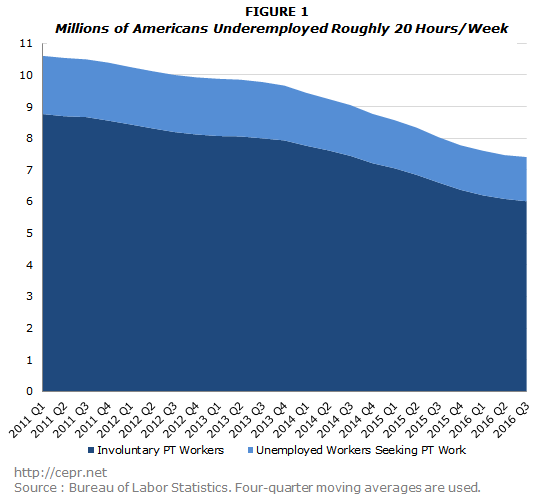Article
Fact-based, data-driven research and analysis to advance democratic debate on vital issues shaping people’s lives.
Center for Economic and Policy Research
1611 Connecticut Ave. NW
Suite 400
Washington, DC 20009
Tel: 202-293-5380
Fax: 202-588-1356
https://cepr.net
This is the last blog post in a three-part series on the Affordable Care Act’s potential effects on part-time employment. The first and second posts can be read here and here.
The first blog post in this series looked at Obamacare’s effect on voluntary part-time employment, arguing that the law may have given workers the freedom to shift from full-time to part-time schedules. The second post said that when some workers cut back on their hours, it likely freed up opportunities for other workers. According to the post, this allowed part-time workers seeking full-time jobs to increase their hours. It may also have given unemployed workers seeking part-time jobs a better shot at being hired.
Instead of advancing a new argument about Obamacare’s effect on part-time work, this post simply examines the changes in different types of part-time employment over the past couple of years. Regardless of whether we believe that Obamacare is behind these positive changes, it’s clear that the forecasts made by the law’s critics simply haven’t come true.
It is worth noting that part-time employment is actually down slightly since before Obamacare went into effect. But more importantly, the experience of working part-time has itself improved dramatically. For instance, the share of part-time workers with health insurance increased nearly 6 percentage-points between 2013 and 2014. And after three years of completely stagnant wages, part-time workers saw significant wage growth beginning in 2014. If Obamacare is supposed to immiserate part-time workers, this misery isn’t showing up in the data; if anything, part-time workers’ wages and benefits both began rising right when the Affordable Care Act (ACA) went into effect.
And even the very slight decline in the number of part-time workers masks a positive story: since 2013, voluntary part-time employment is up, while involuntary part-time employment is down. Unemployment among workers seeking part-time jobs has fallen as well.
The table below shows the number of voluntary part-time workers, involuntary part-time workers, and unemployed workers seeking part-time jobs for both 2013 and the last 12 months. Contrary to the story of employers cutting workers’ hours, the number of involuntary part-time workers is down 1.9 million. The number of voluntary part-time workers – people who choose to work part-time – is up 1.6 million, while the number of unemployed workers seeking part-time jobs is down by 336,000.
The last column in the table shows the number of Americans who are “underemployed.” This category consists of both unemployed Americans seeking part-time jobs and people holding down part-time jobs while looking for full-time ones. Based on data from the BLS, it appears that involuntary part-time workers and unemployed part-time workers are “underemployed” by about the same number of hours – roughly 20 per week.[1,2] The total number of “underemployed” Americans has declined by 2.3 million relative to 2013, a drop of over 23 percent.
As was noted in this series’ first post, voluntary part-time employment showed no upward trend before the implementation of the ACA – it only began increasing in 2014. A similar phenomenon holds when examining the decrease in underemployment. The figure below shows a four-quarter moving average of the number of underemployed Americans from the first quarter of 2011 to the third quarter of 2016. During the 2.75 years preceding the ACA (2011 Q1 to 2013 Q4), the number of underemployed Americans fell by 942,000; involuntary part-time employment fell by 836,000, while the number of unemployed workers seeking part-time jobs fell by 105,000. Over the last 2.75 years, underemployment has fallen by the amounts shown in the table above. The decline in both involuntary part-time employment and unemployment among part-time workers has actually accelerated since the ACA went into effect. (Note that the decline would appear even more dramatic if we were to account for growth in the civilian labor force.)

Since the ACA took effect at the beginning of 2014, all of the changes in part-time employment have been positive. The “good” type of part-time work – voluntary part-time employment – is up significantly, while the number of involuntary part-time workers is down almost 2 million. Additionally, the number of unemployed part-time workers has fallen nearly 20 percent, resulting in over 300,000 people finding jobs. Finally, more part-time workers are receiving health insurance coverage. In fact, the uninsured rate for part-time workers fell 5.8 percentage-points in 2014, and their pay began rising at that point as well.
When we look at the changes in part-time employment over the past three years, we don’t see any evidence of the nightmare scenario that many of the ACA’s critics had predicted. Employers aren’t forcing workers into low-paying part-time jobs as a way of trying to keep down insurance costs. Instead, more workers are choosing to increase their leisure time, and part-time workers are finding it easier than ever to buy health insurance. In short, Obamacare isn’t hurting workers – it’s helping them.
[1] Voluntary part-time workers are employed an average of 20 hours per week. If the preferences of unemployed workers seeking part-time jobs mimic the preferences of people who already work part-time jobs, we can assume that unemployed workers seeking part-time jobs want to work about 20 hours per week.
[2] On average, involuntary part-time workers are employed about 23 hours per week, while full-time workers are employed 42-43 hours per week. We can therefore assume that the typical employee who is involuntarily working part-time would prefer to work an additional 20 hours per week.
